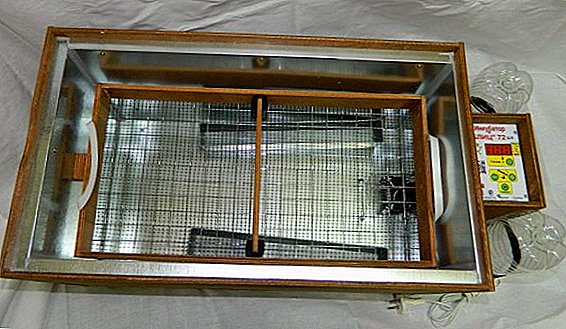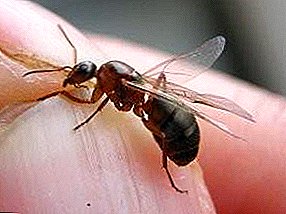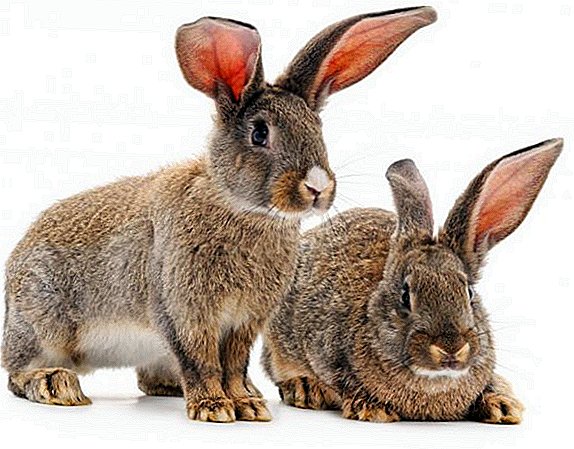 No animal is as sensitive to conditions as a rabbit. These fur-bearing animals react subtly to the slightest mistakes of the owner, and any oversight can very quickly lead to a serious disease or even death of the entire livestock. However, there is a very simple way to quickly detect a change in the state of a crawl. To do this, just touch his long ears.
No animal is as sensitive to conditions as a rabbit. These fur-bearing animals react subtly to the slightest mistakes of the owner, and any oversight can very quickly lead to a serious disease or even death of the entire livestock. However, there is a very simple way to quickly detect a change in the state of a crawl. To do this, just touch his long ears.
The effect of temperature on the rabbit
Rabbits are susceptible to temperature fluctuations, and therefore these warm-blooded animals need to make great efforts to maintain a constant body temperature.  Surprisingly, long, up to half of the total length of the body, the ears are needed by the rabbits not at all in order to recognize the danger in time and react to it, but for thermal control.
Surprisingly, long, up to half of the total length of the body, the ears are needed by the rabbits not at all in order to recognize the danger in time and react to it, but for thermal control.
Did you know? Fleeing from danger, the hare can reach speeds of up to 72 km / h, which makes it almost elusive for most predators. However, the dull slowness of a rabbit, a close relative of the hare, is very deceptive. If necessary, the animal is able to move at a speed of up to 56 km / h, so that a person whose speed record is 44 km / h, and the average running speed with good fitness is no more than 20 km / h, there is no chance catch up with your pet, if he wants to slip away from the owner.Auricles of a rabbit are pierced with a multitude of blood vessels, but there is practically no wool covering on them. This system allows the animal to use the ears as a kind of conditioner in the heat and heater in the cold season.

It works like this:
- If the animal becomes hot, the blood vessels on its ears expand and begin to pass through a large amount of blood, which, moving through the thin and hairless ears, gradually cools due to contact with the air and, returning to the animal body, increases the heat transfer process.
- When the animal freezes, the opposite happens: the blood vessels constrict and the blood circulates only through the organs protected by a thick fur coat, keeping the maximum amount of heat inside the body.
Did you know? Interestingly, in the same way, long tails in rats and the huge horns of the African wild bull, ankole-vatusi, help regulate the temperature.Thus, the body temperature of a healthy rabbit remains relatively constant (relatively, because the range of the normal temperature of this animal varies slightly depending on the time of year: at normal rates of 38.8-39.5 ° C, in winter it can drop to 37 ° C , and in the summer to rise to 40-41 ° C), but the ears can be very cold or very hot, if the beast freezes or overheats.

Signs of ear disease
Too big ears often cause serious problems to rabbits, becoming a hotbed of various kinds of infections. The fact that there is something wrong with the pet's ears can be judged by the following symptoms (one or more in total):
- a large amount of earwax begins to accumulate in the ears, which in certain cases completely clogs the ear canal;
- pus appears in the ears;
- red spots, nodules, wounds and sores, covered with scabs or caked blood, or small hillocks turning into dropsy, filled with liquid, which eventually burst, leaving scabs on the inner side of the auricle, and sometimes also on the eyelids;
- the ears become hot and the tip of the nose dry;
- The rabbit shakes its head from time to time, often tries to scratch its ears with its paws, rub it against any solid object in the vicinity, in a word, according to the behavior of the animal, obviously, the disease is accompanied by severe itching;
- ears are always in a down position;
- the head constantly falls on its side or leans forward;
- increases the overall body temperature of the animal;
- the rabbit often breathes heavily;
- the animal becomes sluggish and weak or, on the contrary, behaves nervously and restlessly;
- loss of appetite or a complete rejection of food;
- refusal of females from mating, deterioration of reproductive functions;
- loss of coordination of the animal.

Why does rabbit have hot ears
Hot ears in a rabbit can be caused by two reasons:
- overheating;
- a disease.
Important! A temporary increase in the temperature of the rabbit's ears can be caused not by the hot air, but by over-stimulation (overwork) of the animal. The ears begin to cool the body of the animal, just as sweat cools the human body during an active workout.You can help lower the temperature of your pet's body by gently rubbing its ears with gauze or a napkin previously soaked in water at room temperature (by no means cold, otherwise the blood vessels will narrow, lowering the heat transfer in the body).
 In addition, you need to very carefully ensure that water does not flow into the ear canal. These activities are not a treatment, but only the first help of the animal. If his condition is not limited to hot ears, first of all, it is necessary to establish an accurate diagnosis.
In addition, you need to very carefully ensure that water does not flow into the ear canal. These activities are not a treatment, but only the first help of the animal. If his condition is not limited to hot ears, first of all, it is necessary to establish an accurate diagnosis.Psoroptosis or scabies
Psoroptosis, or scabies, is a common disease in rabbits. Its causative agent is the mite Psoroptos cuniculi. He, like other blood-sucking parasites, is very attracted to those very numerous blood vessels that help the cat to escape from cold and heat. The bloodsucker with its proboscis disrupts the integrity of the tissues of the external auditory canal, and, in addition, poisons the animal with toxins released during its vital activity. As a result, the rabbit experiences severe itching, and its owner can observe all the other symptoms of psoroptosis according to the above list.  At later stages, the animal may even lose its orientation in space, which indicates a transition of infection to the middle and inner ear. In addition, the skin affected by a tick becomes an object of attack of another pathogenic microflora, including streptococci, staphylococci and other pathogenic bacteria, which sometimes leads to the development of purulent meningitis and death of the animal.
At later stages, the animal may even lose its orientation in space, which indicates a transition of infection to the middle and inner ear. In addition, the skin affected by a tick becomes an object of attack of another pathogenic microflora, including streptococci, staphylococci and other pathogenic bacteria, which sometimes leads to the development of purulent meningitis and death of the animal.
The incubation period of psoroptosis lasts from one to five days. The disease can strike rabbits of any age, but most often animals older than four months are susceptible to it. Infection occurs from sick individuals, and the infection spreads very quickly: when an animal itches or shakes its head, along with dying skin flakes, mites fall out of its ears and immediately move to other rabbits.
Important! Psoroptos cuniculi does not parasitize in humans, so a person cannot get infected with ear from rabbits, but it can infect their pets by bringing the pathogen of this dangerous disease on their clothes or shoes.In order to accurately diagnose psoroptosis, laboratory tests are not necessary. Using a plastic scapula or other convenient object, it is necessary to remove a small piece of dead skin on the inner side of the rabbit auricle, place it in a fatty substance preheated to 40 ° C (for example, petroleum jelly) and carefully armed with a magnifying glass. The size of Psoroptos cuniculi is a little more than half a millimeter, however, it is quite possible to consider a magnifying glass and an adult individual, and even its larvae.
 Having identified specific symptoms, it is urgent to begin treatment. To do this, you can use traditional methods or resort to more civilized assistance of official medicine, however, in fact, and in another case, first of all, it is necessary to carefully remove pus and dead skin flakes from the affected auricle, after having softened the skin with hydrogen peroxide (it is impossible to scrap In no case, only the layer that falls off itself is removed).
Having identified specific symptoms, it is urgent to begin treatment. To do this, you can use traditional methods or resort to more civilized assistance of official medicine, however, in fact, and in another case, first of all, it is necessary to carefully remove pus and dead skin flakes from the affected auricle, after having softened the skin with hydrogen peroxide (it is impossible to scrap In no case, only the layer that falls off itself is removed).Find out what kind of sores in rabbit ears.
Traditional medicine offers the following treatment options for ear scabies in rabbits:
- Apply to each ear glycerin mixed with an alcohol solution of iodine 5% (1: 4 ratio). Repeat the procedure daily until complete recovery.
- Every day, lubricate the affected areas of the ear with camphor oil.
- Mix turpentine or birch tar (terpenes) with any vegetable oil in a 2: 1 ratio and lubricate the received ointment on the ears. This mixture is too toxic for daily use, the procedure can be repeated no sooner than after 2 weeks.
- As in the previous recipe, you should take turpentine and vegetable oil, but in equal parts, add to the mixture a phenol-free coal-free creolin in the same volume as the other two components. Creolin has a pronounced acaricidal effect, including in relation to Psoroptos cuniculi. Means is used daily.
Video: treatment of psoroptosis in rabbits
Such drugs include, for example:
- Acrodex;
- Dermatosol;
- Dikrezil;
- Psoroptol;
- Cyodrin.
Did you know? Rabbits in any case can not be raised up, holding the ears. In the wild, animals are often attacked from the air, so the force pulling the rabbit up causes him a real panic and can even cause illness. You can take an animal in your hands only from below, dropping down to it so that the fluffy can see what is happening to him.There are no less effective drugs, produced in the form of drops and emulsions, which process the surface of the ear according to the technology described above for traditional medicine recipes. This list should include the following tools:
- Neocidol;
- Foxim;
- Sulfidophos;
- Chlorophos;
- Dekta;
- Butox 50;
- Valekson;
- Deces;
- Mustang;
- Stomazan;
- Neostomazan;
- Cypermethrin.

At the initial stage of the disease, a single application of any of the above-mentioned drugs is sufficient for treatment; in advanced cases, treatment is carried out twice with an interval of 1-2 weeks (in accordance with the instructions). In addition, the treatment of psoroptosis in rabbits can be carried out by injection (the injection is made subcutaneously in the withers, intramuscularly in the thigh, or directly into the ear). Drugs used for this purpose:
- Baymek;
- Ivomek;
- Ivermectin;
- Selamectin.
Important! For pregnant rabbit, these injections are contraindicated, treatment in this case is carried out only with topical medications.
Purulent otitis
Unlike psoroptosis, the causative agent of purulent otitis in rabbits is a virus. The symptoms of the disease are very similar to the ear scabies, but at the same time there may be indigestion (diarrhea). There are no accretions on the auricle. Another characteristic sign of purulent otitis is that the animal turns its eyes unnaturally. If a mite or its larvae is not detected during the study of scraping the ears, this also suggests the viral nature of the disease.  Viral infections are almost impossible to cure with drugs, but antibiotics are still prescribed in such cases, since a weakened animal often becomes a victim of the activation of various pathogenic microflora. The treatment is carried out by instillation of anti-inflammatory drugs into the ears, lubrication of the ears with Zoderm or Otodepinom, as well as injections of Cefabol, Oxytetracycline and other antibacterial agents (prescribed by a veterinarian).
Viral infections are almost impossible to cure with drugs, but antibiotics are still prescribed in such cases, since a weakened animal often becomes a victim of the activation of various pathogenic microflora. The treatment is carried out by instillation of anti-inflammatory drugs into the ears, lubrication of the ears with Zoderm or Otodepinom, as well as injections of Cefabol, Oxytetracycline and other antibacterial agents (prescribed by a veterinarian).
Important! The scheme and course of treatment of purulent otitis can only be prescribed by a veterinarian, you should not use antibiotics yourself, this can lead to the death of the animal, as well as the formation of antibiotic-resistant bacteria strains.
Why does rabbit have cold ears
If hot ears in a rabbit are evidence of its overheating or the development of an infectious disease, then lowering the temperature of this organ is a clear sign of hypothermia. In severe cases, even frostbite of the ears can occur: the blood does not circulate through the narrowed blood vessels, most of it remains in the body of the animal, saving him from hypothermia, as a result, the ear tissue begins to damage and die.  Frostbite in rabbit ears goes through three stages:
Frostbite in rabbit ears goes through three stages:
- Ears become cold, red and swollen. At this stage the animal experiences severe pain.
- Blisters appear on the ears, which eventually burst, releasing a turbid liquid with bloody clots. Wool on the outside of the ears falls out, the rabbit can no longer hold them vertically.
- On the ears appear blackened areas - foci of necrosis.
Important! In any case, a rabbit with signs of frostbite in the ears should be placed in a warm room until full recovery.
Preventive measures
To avoid problems with the ears of fluffy pets, you must strictly observe the following preventive rules:
- the temperature in the room where rabbits are kept should strive for an optimal range from +15 to +17 ° C (below +10 ° C and above +25 ° C - an unacceptable deviation from the norm);
- in the hot season, the rabbits should be given as much water as possible, making sure that it is a little cool, and to reduce the room temperature to use any available means — for example, to put plastic bottles of frozen water in cages;
- cages with rabbits can not be kept near the solar windows, where the animal can get a heat stroke, not being able to hide from the heat;
- regular airing of the room is an obligatory part of rabbit care;
- provide their pets with a sufficient amount of juicy feed, fresh or slightly dried grass;
- observe the sanitary rules for keeping animals - regularly clean the cages and feeders, change the dirty litter, clean up the remnants of food and change the water in the troughs;
- put on a two-week quarantine of all newly acquired animals;
- implement timely vaccination of livestock;
- not to allow too heap animals in the rabbit or cage;
- timely treat rabbits with antiparasitic drugs for prophylactic purposes;
- Regularly conduct routine inspections of each individual from its herd and immediately place animals that have even minor signs of infection on quarantine.
 The condition and temperature of the rabbit's ears are a kind of indicator of the state of health of the animal. If the ears of the animal dramatically change their temperature - this is a sign that something is wrong with his condition. In no case can this symptom be left unattended.
The condition and temperature of the rabbit's ears are a kind of indicator of the state of health of the animal. If the ears of the animal dramatically change their temperature - this is a sign that something is wrong with his condition. In no case can this symptom be left unattended.Read also about whether to raise rabbits by the ears.
If there are no other signs of disease, it is necessary to analyze and, if necessary, correct the temperature in the room where animals are kept, but the presence of additional symptoms of ear diseases is a reason for taking urgent and adequate measures to help the affected individual and prevent the spread of infection to other members of the herd.












